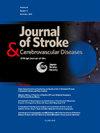非外伤性颈动脉与椎动脉夹层的差异结局和治疗:一项全国住院患者样本研究。
IF 2
4区 医学
Q3 NEUROSCIENCES
Journal of Stroke & Cerebrovascular Diseases
Pub Date : 2025-02-01
DOI:10.1016/j.jstrokecerebrovasdis.2024.108170
引用次数: 0
摘要
颈动脉夹层(CAD)涉及颈动脉或椎动脉。然而,有限的研究比较了他们的临床特征和结果。方法:我们检查了全国住院患者样本(2005-2019)中的非创伤性CAD患者。同时诊断为颈动脉和椎动脉夹层者排除在外。评估包括患者人口统计、合并症和治疗。使用调查加权逐步回归logistic回归评估颈动脉和椎体夹层之间的差异,然后对住院死亡率和常规出院(回家或自我护理)的主要结局进行调整多变量回归。结果:从2005年到2019年,我们纳入了123,224例无并发椎动脉和颈动脉夹层的非创伤性CAD入院患者。颈动脉夹层多于椎体夹层(67,533例对55,691例)。与椎体夹层相比,颈动脉夹层与年龄较大相关(54[44-66]岁vs. 49[37-62]岁)。结论:我们的研究强调了非创伤性颈动脉夹层组和椎体夹层组之间不同的共病特征和治疗模式。这些发现提倡根据解剖类型定制治疗策略,以优化患者的预后。本文章由计算机程序翻译,如有差异,请以英文原文为准。
Differential outcomes and treatment in non-traumatic carotid versus vertebral cervical artery dissection: A national inpatient sample study
Introduction
Cervical artery dissection (CAD) involves the carotid or vertebral artery. However, limited studies have compared their clinical features and outcomes.
Methods
We examined non-traumatic CAD patients from the National Inpatient Sample (2005-2019). Those diagnosed with both carotid and vertebral artery dissections were excluded. The evaluation included patient demographics, comorbidities, and treatment. Differences between carotid and vertebral dissections were assessed using survey-weighted stepwise backward logistic regression, followed by adjusted multivariable regressions for the primary outcomes of in-hospital mortality and routine discharge (to home or self-care).
Results
From 2005 to 2019, we included 123,224 non-traumatic CAD admissions without concurrent vertebral and carotid dissections. There were more carotid dissections than vertebral dissections (67,533 vs. 55,691). Compared to vertebral dissection, carotid dissection was associated with older age (54 [44-66] years vs. 49 [37-62] years, P<0.001), Black race (12.6% vs. 8.8%, P<0.001), White race (73.5% vs. 72.0%, P = 0.024), atrial fibrillation (10.8% vs. 6.3%, P<0.001), aortic dissection (7.7% vs. 0.3%, P<0.001), and fewer concurrent acute ischemic strokes (AIS) (47.8% vs. 56.7%, P<0.001).Within the concurrent AIS group, carotid CAD patients exhibited higher NIHSS (8 [2-17] vs. 2 [0-5], P<0.001), an increased utilization of intravenous thrombolysis (6.7% vs. 2.7% P<0.001), endovascular therapy (13.3% vs. 3.3%, P<0.001), and angioplasties (9.8% vs. 0.3%, P<0.001). Overall, carotid CAD was associated with more inpatient deaths (aOR 1.30, 95% CI 1.04-1.62, P=0.023) and less routine discharges (aOR 0.88, 95% CI 0.79-0.97, P=0.014) than vertebral CAD.
Conclusion
Our study underscores distinct comorbidity profiles and treatment patterns between non-traumatic carotid dissection and vertebral dissection groups. These findings advocate for tailored treatment strategies based on dissection type to optimize patient outcomes.
求助全文
通过发布文献求助,成功后即可免费获取论文全文。
去求助
来源期刊

Journal of Stroke & Cerebrovascular Diseases
Medicine-Surgery
CiteScore
5.00
自引率
4.00%
发文量
583
审稿时长
62 days
期刊介绍:
The Journal of Stroke & Cerebrovascular Diseases publishes original papers on basic and clinical science related to the fields of stroke and cerebrovascular diseases. The Journal also features review articles, controversies, methods and technical notes, selected case reports and other original articles of special nature. Its editorial mission is to focus on prevention and repair of cerebrovascular disease. Clinical papers emphasize medical and surgical aspects of stroke, clinical trials and design, epidemiology, stroke care delivery systems and outcomes, imaging sciences and rehabilitation of stroke. The Journal will be of special interest to specialists involved in caring for patients with cerebrovascular disease, including neurologists, neurosurgeons and cardiologists.
 求助内容:
求助内容: 应助结果提醒方式:
应助结果提醒方式:


